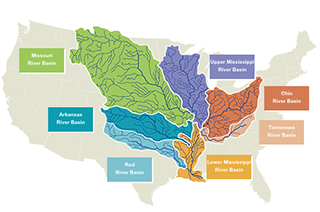The Mississippi River watershed is in drastic need of additional funding for infrastructure maintenance and improvements, according to a report issued by America’s Watershed Initiative, a collaborative group composed of representatives from business, government and conservation and civic organizations.
In a 79-page report on the watershed, the group – whose steering committee includes Dan Mecklenborg, chief legal officer at Ingram Barge – rated infrastructure conditions as “poor” and issued a failing grade to infrastructure maintenance efforts along the river and its main tributaries.
According to the report, “Transportation in the basin is compromised by the lack of adequate funding for maintenance … Delays at locks and dams currently are moderate but are at serious risk of catastrophic failure, as already poor condition infrastructure receives inadequate maintenance funding.”
The report investigated the Upper and Lower Mississippi River basins, as well as the basins of the Ohio and Tennessee Rivers to the east of the Mississippi, and the basins of the Missouri River, Arkansas River and Red River to the west.
Harald “Jordy” Jordahl, director of America's Watershed Initiative, said the report was compiled to determine the condition of the Mississippi River watershed and to identify the connections between its economy, transportation structures, ecosystems, water supply, flood control and recreation opportunities.
“Improving the future of the watershed requires improvement in all of these areas, and that in turn requires coordination and collaboration between diverse groups, including industry, agriculture, environmental and recreational groups and local, state and federal governments,” Jordahl said.
However, Jordahl expressed particular concern with the watershed’s infrastructure maintenance, as it received the only failing grade of the 19 indicators used to determine the overall health of the watershed.
“When you look at the condition of critical components throughout the lock and dam system, there are concerns regarding infrastructure condition based on the data we reviewed,” Jordahl said. “Combine that with the inadequacy of maintenance funding and we have a concern, though the system seems to be working effectively today.”
Commercial navigation in the entirety of the Mississippi River watershed, which stretches across 31 states, accounts for about 92% of national farm experts, representing about $54 billion annually. Barge traffic in the watershed provides a “vital” and “cost-effective” method of providing the agricultural, energy and manufacturing sectors with materials and transportation to national and global markets, the report said.
“Sustaining and increasing this capacity through infrastructure maintenance, rehabilitation, updates and innovations is necessary in order to maintain a competitive economy that benefits an increasing number of people throughout the world,” it said.
The system of locks and dams in the Mississippi River basin watershed was mostly built between 1850 and 1950. The Inland Waterways Trust Fund, financed by a tax on fuel used in navigation, provides some money for infrastructure improvements, but “at current levels, the trust fund is not able to meet the needs,” according to the report, and “the lack of funding for system maintenance is widely expected to increase the number of components that fail and will likely significantly increase lock delays and decrease overall system performance.”
Due to budget shortfalls, the U.S. Army Corps of Engineers, which is responsible for operation and maintenance of the basin’s lock-and-dam system, reports increasing amount of deferred maintenance throughout its entire assortment of civil works. Funding in recent years “consistently underestimates the amount needed to keep inland navigation infrastructure operating,” the report said.
The report showed how even short bursts of extra spending on infrastructure can have measurable economic effects. The additional construction and maintenance performed in 2010 and 2011, during which time funding briefly rose for projects in the Mississippi River basin identified as high-need by the Corps of Engineers, resulted in fewer shipping delays in the years since, most notably in the Upper Mississippi and Ohio basins, according to the report.
Decisions by Congress to eliminate earmarking and to implement sequestration, which temporarily reduced funding to all Corps of Engineers programs, have in recent years cut funding for infrastructure in the country’s waterways and disrupted the planning and budgeting process for future work, the report concludes.





